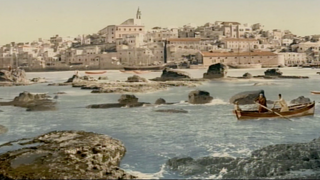The only candle in our line inspired by a city, our Signature Jaffa Candle pays homage to the city of Jaffa with art representing its scenic coastline, once a significant trade route and hub. Designer and illustrator Erum Khalili's interest in nature and textures made it possible to illuminate a piece of Jaffa history on our citrus scented candle.
Jaffa is a Palestinian village and namesake of the oranges from which they originated. It also happens to be a port city that lives in the memories of Palestinians around the world in the same iconic way the image of the Hollywood sign is embedded in the minds of people everywhere regardless of whether they ever set foot in California. Though I've never been and though my own family is from Silwan in East Jerusalem, outside the seaside village, the mere mention of Jaffa conjures visually stunning coastal blues lined with adobe stone style homes of the centuries old city.
 Countless illustrations date back to the 19th century, followed later by photographs, conveying Palestine’s rich agricultural legacy. The once globally recognized Jaffa Oranges thrived as a Palestinian brand and export that bolstered Palestine's agricultural industry only to be met by its cultural and economic decline leading up to the Nakba.
Countless illustrations date back to the 19th century, followed later by photographs, conveying Palestine’s rich agricultural legacy. The once globally recognized Jaffa Oranges thrived as a Palestinian brand and export that bolstered Palestine's agricultural industry only to be met by its cultural and economic decline leading up to the Nakba.


The rise of the industrial revolution coincided with the cultivation of the new citrus variety being cultivated by Arab farmers in Palestine, allowing for the crop's rapid expansion. Jaffa Orange exports from Palestine grew from 200,000 to 38 million between 1845 and 1870, a significant acceleration in volume and area expansion of their orange groves. The labor intensive endeavor was sustained by farmers with a firsthand understanding and knowledge of the land to grow the fruit coveted for uniquely having few seeds and a tough skin, ideal for exporting. This single export coupled with Raed's photography not only debunked fictional suggestions of a "land without a people", but it connected the world to a bustling life and provided insight into a thriving economy.
Jaffa Oranges became so desired that other countries tried to pass their lesser citrus varieties by stamping their cases with fabricated Jaffa Orange branding. (Note the poster below, on the far right, just below the words "you can" includes the line "grown in Palestine".)
 The design is thanks to Erum's patience as an illustrator, who obliged various iterations and attention to seemingly insignificant details like the cobbled limestone used throughout the architecture of the city. Should the details that decorate the spaces we keep invite opportunities to share stories or offer up pieces of ourselves, the Signature Jaffa Candle is a way to keep the memory and history of Jaffa alive.
The design is thanks to Erum's patience as an illustrator, who obliged various iterations and attention to seemingly insignificant details like the cobbled limestone used throughout the architecture of the city. Should the details that decorate the spaces we keep invite opportunities to share stories or offer up pieces of ourselves, the Signature Jaffa Candle is a way to keep the memory and history of Jaffa alive.

